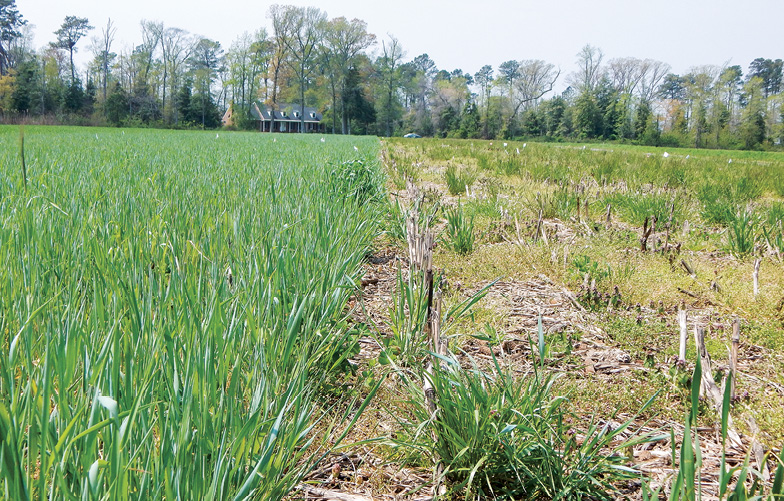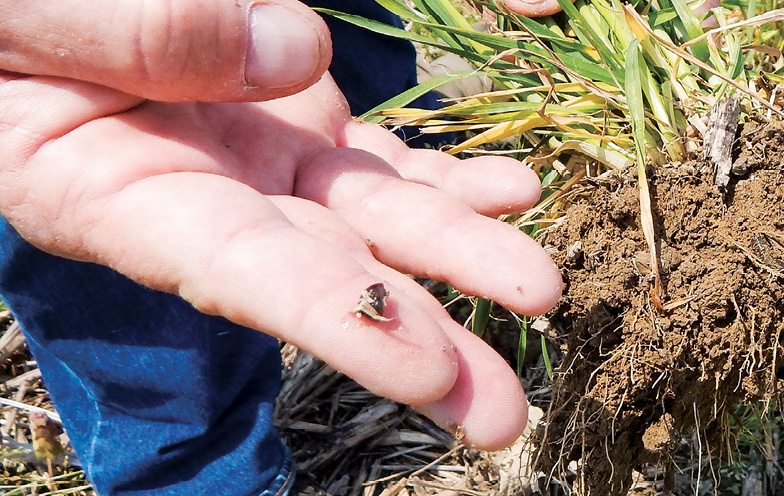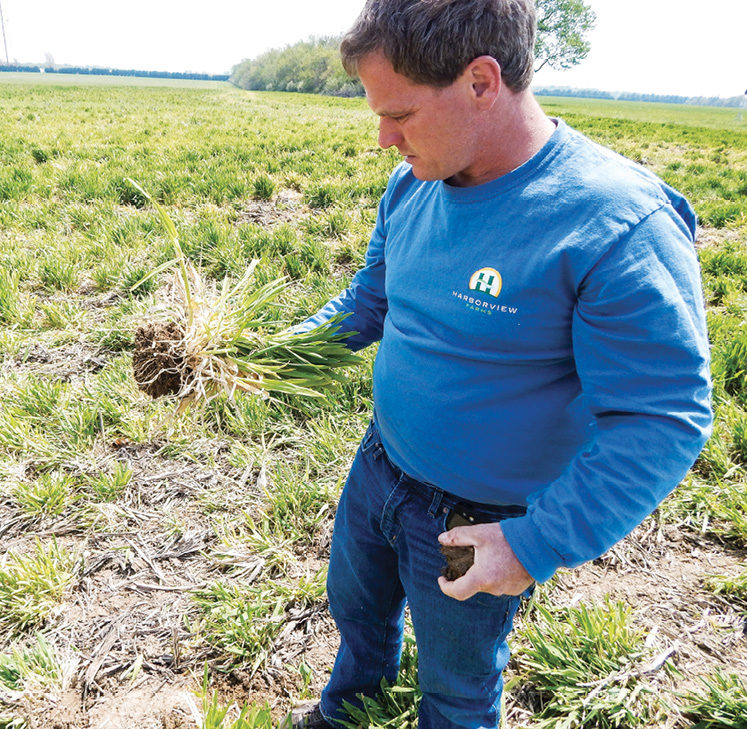Pictured Above: TWEAKING THE PROGRAM. Trey Hill is trying to cultivate the best use of cover crops while designing the best nutrient management program possible on his 10,000-acre family farm. This led him to become part of the Howard G. Buffett Foundation’s High-Yield Conservation project, where he’s doing cover-crop test plots with Ray Weil, a University of Maryland soils specialist.
Although Trey Hill has been farming around 10,000 acres in Rock Hall, Md., his whole life, he’s quick to mention that he’s more a student than a teacher. It’s this instinct that leads him to perpetually tweak his nitrogen (N) management and cover-crop program, forever in search of more conservative and efficient techniques for the fourth generation family-run Harborview Farms.
The motivation behind building a no-till system — which the Hill family has been using on their farm in some capacity for about 40 years — that makes equitable use of cover crops and comprehensive nutrient management is two-fold for Hill.
On one end, he wants to build optimal soil health and follow his inputs to ensure that cost savings are appreciated and return on investment is maximized, but also because being environmentally conscious of the N cycle is an everyday imperative with so many acres hugging the eastern shore of the Chesapeake Bay.
Planting ‘Green’
Hill has been experimenting with cover crops for the past 20 years and still feels that he has much to learn. Now 100% cover cropped, he makes good use of the Maryland Agricultural Water Quality Cost-Share (MACS) program, which provides cover crop grants in hopes of reducing pollution in the bay.
“Being at 100% cover cropped is a fairly recent development,” Hill says. “We’re on the state program, which pays us to do cereals. We typically use barley because it’s the cheapest. We’re doing some cereal rye too in hopes of helping deal with some root rot issues. We’ve been adding some radish and clover lately as well.”
Hill’s cover-crop seeding practices are a bit of a mixed bag. With both 102-day and 113-day corn on the farm, he opts to seed the shorter season crop with a drill that closely follows the combine. For the longer season corn, he seeds into it with an airplane while the crop is still standing — usually about 2 weeks before harvest. For barley, Hill sticks to the state’s minimum-required seeding rate, which is 3 bushels per acre by plane and 2½ bushels by drill.
“When we get to full-season and double-cropped soybeans, we’ll broadcast cover crops and lightly work them in,” Hill says. “I’ll run a vertical tillage tool over the cover crops, set to barely touch the soil, after a wheat crop to help straw break down and get seed incorporated. We get a pretty good stand out of it and there is still about 90% residue on top.”

“All four cover crop strips let only about 10 ppm of nitrate through vs. almost 40 ppm that leached through the control…”
— Trey Hill
The focus of Hill’s latest efforts have been both understanding how much N his cover crops sequester in the soil profile and when it becomes available again for his primary crop. These questions feed into his larger concern of determining whether or not it’s best to plant into his cover crops green — which is to plant his cash crops into actively growing cover crops, rather than killing them prior.
“I used to terminate covers as early as possible,” Hill says. “We could start terminating on March 1. Our thinking was, the faster you kill them off, the sooner you clean up the seedbed. We were always taught that a clean seedbed was ideal. We did this until about 5 or 6 years ago when we started letting them live longer.”
Hill had heard that some farmers were employing this practice, but didn’t stumble upon the potential benefits until a happy accident occurred. In the middle of terminating crops on the headlands of one field, the sprayer was rained out so the cover in the middle of that field was never killed off. When it came time for planting, the barley was nearly waist high and looked messy, but he noticed immediately how much better planting went where the cover was still green.
“Initially the main reason we started switching was plantability,” Hill says. “Last year we planted about 30-40% green, but this year we have already jumped that up to close to 100%.
“As impatient no-tillers, we’re shooting for that earlier planting date and this seems to help. I think it also insulates the soil and helps protect against the temperature fluctuations that affect emergence even more than cold temperatures do.”
When it comes time to kill off the cover crop, Hill uses Lexar and Touchdown to get a slow termination.
“We wait 2 weeks after planting to spray and it takes 3 weeks for the cover to die off, so the field will actually be green until the corn itself is 6-7 inches tall,” Hill says.
He explains that when he’d kill the cover crops early, earthworms and birds would eat the residue, leaving the soil exposed. The soil would then harden like a typical conventionally tilled field.

PLANTING GREEN. Trey Hill is intent on finding out if planting into living cover crops is the optimum method for his farm. He’s noticed that this practice seems to insulate the soil better than where cover crops were terminated early, which may help with temperature fluctuations that affect emergence even more than cold temperatures do, he says.
“I am worried about competition for nutrient uptake, so we’re looking into that, but my goal is to keep the fields green for as long as possible,” he says.
Studying Nitrogen
While Hill feels comfortable with the assumption that cover crops reduce N leaching and release their nutrients back into the soil profile as they die off, he wanted more precise information regarding just how much N is sequestered and exactly when it becomes available.
To achieve this, he became a part of the High-Yield Conservation Project funded by the Howard G. Buffett Foundation. As part of the program, Ray Weil, a soils specialist from the University of Maryland, set up a test plot on Harborview Farms to examine just how well cover crops were reducing N runoff.
The 10-acre test plot consists of five strips replicated three times: two strips of cover-crop mixes, a strip of cereals, a strip of radishes and a control strip with no cover crops. Lysimeters, which measure how much evapotranspiration is released by plants, were installed 3 feet down to test how much N was running out of the soil.
This spring, Weil pulled samples from the lysimeters on Feb. 3, Feb. 27 and April 3 and tested them for nitrates. The results came back conclusively across all the sample times that N was leaching much more through the control strip.
“All four cover crop strips, regardless of planting date or plant type, let only about 10 ppm of nitrate through vs. almost 40 ppm that leached through the control,” Hill says.
“If I kill the cover crops too early, I have a field of dead stuff so I kind of create a slug environment…”
While these results weren’t necessarily surprising, Hill was reassured to see them reproduced on his own field. The results also lent further credence to his plan to leave the cover crop green for longer. This way, they could continue to sop up nutrients that would otherwise be on their way off the field.
Now, Hill looks forward to the second phase of the test plot, one in which he hopes to delve further into the rate and time at which nitrates may be returning from the cover crop to the growing cash crop.
“We have it already set up, so I am going to just plant corn into the cover crops green and terminate them shortly afterward as I would normally,” Hill says.
He’ll then put down some 30-30-0 to provide enough N to get the corn going and broadcast some 21-20-80-24 to provide additional N and some sulfur.
“The plot is broken up into sections that will get different rates of N; some spots will only get 50 pounds,” he says. “I’ll be interested to see if I’m getting any N back from the clover and the cereal rye.”

STAUNCHING NITROGEN. University of Maryland soils specialist Ray Weil’s first round of testing on Harborview Farm’s test plot revealed that more nitrates escaped the soil profile through the control strip regardless of time or cover crop variety. The 3-foot-deep lysimeters read around 10 ppm of nitrate on ground with cover crops vs. nearly 40 ppm on the ground without covers.
While starving the corn of N, Hill and Weil feel that they can gain useful insight on when and how much fertilizer makes its way back into the cash crop by monitoring the yield response in the strips.
“We’re going to vary the rate of N across all 15 strips but have a control within each strip that has nothing on it,” Hill says. “It’s clear that cover crops pay in soil health, but I’d like to see a quantification of the nutrient value. If it’s 20 pounds of N, that would be pretty substantial and I could make management decisions around that.”
Mandated Fertility
Hill admits that farming in such close proximity to the Chesapeake Bay does make for some inherited expenses in terms of adhering to state regulations. State-mandated nutrient management planning, annual random audited soil tests and restrictions against fall fertilizer applications play some role in determining parts of Harborview Farm’s fertility program, but Hill believes in staying ahead of regulation.
Although in many parts of the country government regulation of farm practices is a serious bone of contention, Hill says that in the northeast section of the Delmarva peninsula, it seems like a positive alliance is forming between environmentalists and farmers. He even takes an active role himself as a board member on the Sassafras River Assn.
“Comparatively, no-tillers and strip-tillers probably have a lot less to worry about when it comes to nutrient management regulations,” he says. “A lot of these practices are already ahead of what might be legislated in the next decade anyway. Many of these farmers are tracking exactly what they’re applying and are already building best practices.”
With restrictions against fall and winter fertilizer application, Hill has to wait until March 15 to begin spreading any litter or manure. Based on annual grid samples of about 20% of the farm, he variable rates 175-200 pounds of N per acre. Depending on the need, about 30 pounds of N is applied through fertigation. The remainder is applied at planting and through a round of liquid 32% topdressed when the corn reaches knee height.

NITROGEN CYCLING. In the second phase of Trey Hill and Ray Weil’s cover crop testing, they hope to examine at what time and rate certain cover crops return nitrogen (N) they’ve sequestered to the soil profile, where the cash crop can then utilize it. The plot is broken up into sections that will receive different rates of N; some spots will only get 50 pounds and yield responses will be compared.
On both of his Case IH sprayers he runs Trimble GreenSeekers to capture the normalized difference vegetation index (NDVI). Since he’d need to convert both his monitors and steering solutions to give the GreenSeeker the ability to control the sprayer, which he’s determine is too expensive, he’s only able to use the NDVI data to inform decisions on subsequent passes.
“In wheat we measure NDVI on the first pass. Then on the second pass, we’re able to use the data from the first to judge application rates,” Hill says. “In corn, we’re basically just taking the NDVI data and seeing how well it agrees with our variable-rate N maps. I’m probably not utilizing the data to its fullest yet, but it will help make important decisions going forward.”
He’s also hoping to soon develop a method for using NDVI data pulled from spraying cover crops to inform nutrient management decisions.
“If I can figure out how to analyze and interpret data from a straight cereal mix, it will let me know where I had excess N from the last year,” Hill says. “Wherever the cereals were really green, I put too much on the previous year, and wherever they’re yellow, I didn’t have enough. That’s a simplified look at it, but that information could be useful.”
Controlling Slugs
In the past, fighting with slugs has been so intense that it temporarily forced Hill back into full tillage in some fields.
“While moving more acres to no-till, we’ve been running into huge issues with slugs,” he says. “The little black half-inch ones are our biggest issue. There are no reliable chemical controls for them.
“Conventional tillage seems to really take care of the slugs if you do it for several years in a row. We don’t like having to do that, but we’ve had slugs eat whole fields of 10-inch corn.”

SLUG STRUGGLES. These small half-inch black slugs are Trey Hill’s biggest hurdle. After trying several different solutions to control their population, he’s found multiple applications of slug bait and the occasional use of suspended liquid potassium seems to be the best solution.
Over the years, Hill has tried DuPont’s Lannate and even applying 32% N at night, both with unsatisfying results.
“Ten gallons or so of 32% at night won’t burn so much corn, but it does melt the slugs,” Hill says. “But still, it really didn’t do much for our issues. Remembering hot spots from previous years tends to help with predictability, but they’re really hard to scout for and there just aren’t insecticides that reliably kill them.”
The two methods Hill did find effective were using Amvac’s Deadline Bullets slug bait and suspended liquid potash. When using slug bait, he says the key has been finding the slug hot spot and reacting to it early with multiple applications.
“It works well if you can get it out quickly, but a good technique has been spreading it at a low rate so it’s still cost effective to do it multiple times if it rains,” Hill says. “It’s sort of the same for the suspended potash. People have told me before that it shouldn’t have an effect, but if I can have it on the ground for 5-6 days, the slugs come up and are melted by it. If it rains though, it doesn’t do anything.”
Although he thinks the last 3 years have been naturally lean in terms of slug infestations, he looks forward to testing another theory he’s heard about planting into green cover crops.
“Some farmers swear that leaving the cover crops green helps control slugs too,” Hill says. “The slugs will probably be able to feed on the other plants and not attack the corn as much.
“If I kill the cover crops too early, I have a field of dead stuff so I create a slug environment. Then, once 28,000 tiny corn plants per acre start to pop up, there really isn’t much else for the slugs to eat so they’ll just devour all the corn.”








Post a comment
Report Abusive Comment